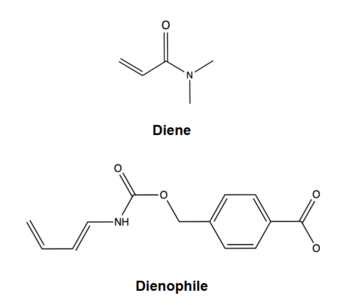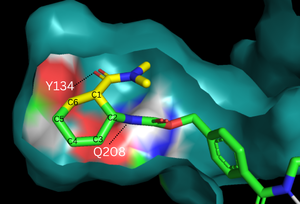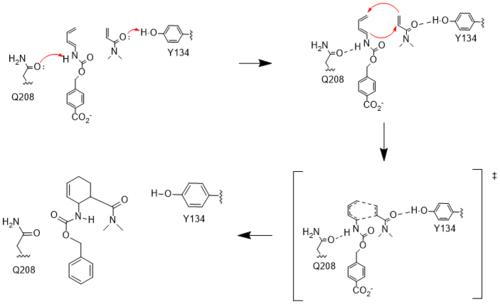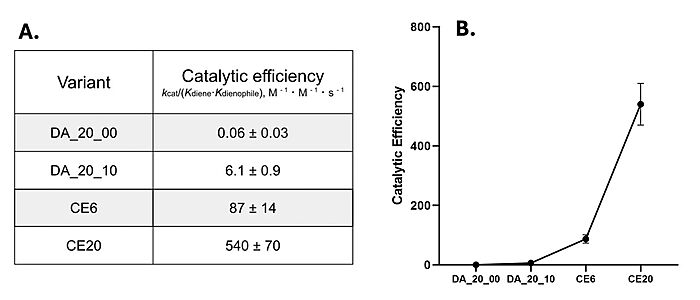Sandbox Reserved 1852
From Proteopedia
(Difference between revisions)
| Line 21: | Line 21: | ||
In the designed active site, <scene name='10/1075254/Active_site/6'>two catalytic residues</scene> stabilize the transition state of the Diels-Alder reaction. The Tyr134 acts as a <scene name='10/1075254/Y134_h_donation/3'>hydrogen bond donor</scene> to the oxygen on the dienophile (see Fig. 2). Q208 acts as a <scene name='10/1075254/208_bond_donor/3'>hydrogen bond acceptor</scene> to the nitrogen on the diene. These interactions help reduce the energetic gap between orbitals allowing the reaction to proceed. | In the designed active site, <scene name='10/1075254/Active_site/6'>two catalytic residues</scene> stabilize the transition state of the Diels-Alder reaction. The Tyr134 acts as a <scene name='10/1075254/Y134_h_donation/3'>hydrogen bond donor</scene> to the oxygen on the dienophile (see Fig. 2). Q208 acts as a <scene name='10/1075254/208_bond_donor/3'>hydrogen bond acceptor</scene> to the nitrogen on the diene. These interactions help reduce the energetic gap between orbitals allowing the reaction to proceed. | ||
====Helix Cap==== | ====Helix Cap==== | ||
| - | In the evolution process, a 16-residue [https://proteopedia.org/wiki/index.php/Alpha_helix alpha-helix] <scene name='10/1075254/Alpha_helix_highlighted/1'> | + | In the evolution process, a 16-residue [https://proteopedia.org/wiki/index.php/Alpha_helix alpha-helix] <scene name='10/1075254/Alpha_helix_highlighted/1'>cap</scene> to the top of the binding site. The hydrophobic helix “functions as a lid to constrain the substrates in a productive orientation for reaction,” decreasing the ''K<sub>m</sub>'' of the enzyme and increasing the catalytic efficiency, as seen in the measured kinetics of the enzyme.<ref name="Eiben">PMID:22267011</ref> |
== Mechanism == | == Mechanism == | ||
[[Image:Resizedmechanism.png|500px|left|thumb|Figure 3. Active site mechanism]] | [[Image:Resizedmechanism.png|500px|left|thumb|Figure 3. Active site mechanism]] | ||
====HOMO and LUMO==== | ====HOMO and LUMO==== | ||
| - | The two active site residues, Y134 and Q208, use hydrogen bonding to | + | The two active site residues, Y134 and Q208, use hydrogen bonding to assist in the reaction by closing the energy gap between the molecules. By donating a hydrogen, via Tyr134, the energy of the highest occupied molecular orbital (HOMO) is increased. Conversely, by abstracting a hydrogen, via Q208, the energy of the lowest unoccupied molecular orbital (LUMO) is decreased. As a result, the energy gap between the |
====Hydrogen Bonding==== | ====Hydrogen Bonding==== | ||
Rather than using [https://en.wikipedia.org/wiki/Acid_catalysis acid-base catalysis], the Diels-Alderase utilizes hydrogen bonding to alter the HOMO and LUMO energies of the diene and dienophile. Tyr134 donates a hydrogen bond to the dieneophile, increasing its electron density and lowering its LUMO. Glu208 accepts a hydrogen bond from the diene, decreasing its electron density and lowering its HOMO. | Rather than using [https://en.wikipedia.org/wiki/Acid_catalysis acid-base catalysis], the Diels-Alderase utilizes hydrogen bonding to alter the HOMO and LUMO energies of the diene and dienophile. Tyr134 donates a hydrogen bond to the dieneophile, increasing its electron density and lowering its LUMO. Glu208 accepts a hydrogen bond from the diene, decreasing its electron density and lowering its HOMO. | ||
| Line 41: | Line 41: | ||
DA_20_10 provided key mutations in and around the active site that increased the hydrophobicity, provided structural stability, and increased interactions between the ligand and surrounding residues. | DA_20_10 provided key mutations in and around the active site that increased the hydrophobicity, provided structural stability, and increased interactions between the ligand and surrounding residues. | ||
=====Q162R===== | =====Q162R===== | ||
| - | :Glu 162, a <scene name='10/1075254/Q162/ | + | :Glu 162, a <scene name='10/1075254/Q162/3'>glutamine</scene>, resides near the top of the binding site, and is about than 3Å from the ligand in most models on the enzyme. It can act as a hydrogen bond donor to the terminal phosphate on the ligand when in proximity. To increase this interaction, Glu162 was mutated to an <scene name='10/1075254/Q_to_r/2'>arginine</scene>, which decreased the length of the potential hydrogen bond to within 2.5Å in most models, increasing the strength of the interaction.<ref name="Siegel"/> |
=====S284A===== | =====S284A===== | ||
| - | :Ser 284 resides deep within the binding pocket of the enzyme. Choosing a <scene name='10/ | + | :Ser 284 resides deep within the binding pocket of the enzyme. Choosing a <scene name='10/1075254/S284/1'>serine</scene> to <scene name='10/1075254/A285_scence/1'>alanine</scene> mutation increases the hydrophobicity of the binding pocket and reduce reactivity, without also changing any steric characteristics in the region ''unintentionally'' near the catalytic residues.<ref name="Siegel"/> |
=====A285N===== | =====A285N===== | ||
:<scene name='10/1075254/N285/3'>N285</scene>, as follows, is also buried within the binding pocket. Introducing this mutation increases steric hindrance with the catalytic tyrosine, reducing the number of rotamers the residue has to increase the reactivity of the enzyme by lowering the distance between Y134 and the ligand.<ref name="Siegel"/> | :<scene name='10/1075254/N285/3'>N285</scene>, as follows, is also buried within the binding pocket. Introducing this mutation increases steric hindrance with the catalytic tyrosine, reducing the number of rotamers the residue has to increase the reactivity of the enzyme by lowering the distance between Y134 and the ligand.<ref name="Siegel"/> | ||
Revision as of 01:48, 24 April 2025
| This Sandbox is Reserved from March 18 through September 1, 2025 for use in the course CH462 Biochemistry II taught by R. Jeremy Johnson and Mark Macbeth at the Butler University, Indianapolis, USA. This reservation includes Sandbox Reserved 1828 through Sandbox Reserved 1846. |
To get started:
More help: Help:Editing |
Diels-Alderase
| |||||||||||




